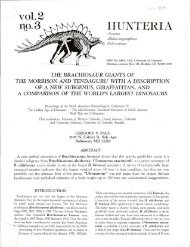THE MANY MYTHS, SOME OLD, SOME NEW, OF ... - Gregory S. Paul
THE MANY MYTHS, SOME OLD, SOME NEW, OF ... - Gregory S. Paul
THE MANY MYTHS, SOME OLD, SOME NEW, OF ... - Gregory S. Paul
You also want an ePaper? Increase the reach of your titles
YUMPU automatically turns print PDFs into web optimized ePapers that Google loves.
DINOSAUR <strong>MYTHS</strong> 77<br />
Reality: In historical terms dinosaur endothermy is a radical concept, but traditional<br />
consensus that favored reptilian dinosaur metabolics was never subjected to rigorous<br />
scientific scrutiny, so it has limited bearing on the current scientific debate. Models<br />
that blend reptilian with avian-mammalian characters are not superior just because<br />
they attempt to reach a compromise or a consensus, they may be just as false as other<br />
models. Following the basic engineering principle that machines that are built much<br />
the same way operate much the same way, it is a straightforward and entirely logical<br />
matter to apply to dinosaurs, that were so like birds and mammals, a nonreptilian<br />
physiology that is patterned after those of birds and mammals.<br />
IF YOU BELIEVE DINOSAURS WERE TACHYMETABOLIC<br />
ENDO<strong>THE</strong>RMS, PROVE IT, BUT IT'S OK TO THINK<br />
THAT DINOSAURS HAD INSECT-LIKE PHYSIOLOGIES<br />
Myth: The burden of proof lies upon those who wish to show that dinosaurs had<br />
avian-mammalian like energetics. It is more prudent to believe that, although<br />
dinosaurs had sustained activity levels approaching those of mammals and birds,<br />
their standard metabolic rates were closer to those of reptiles.<br />
Reality: While it is known that tachymetabolic endothermy works in large tropical<br />
animals similar in design, size and activity levels to dinosaurs, not one example of a<br />
living or extinct tropical animal similar in design to dinosaurs, or much over one<br />
tonne, that combines a double pump heart with reptilian SMR (as per Regal and<br />
Gans, 1980; Reid, 1987) has been positively identified. In addition, Bennett and<br />
Ruben (1979) stress that in all vertebrates the SMR is a high percentage of sustained<br />
active metabolic rates, so all active vertebrates must have high SMR's! Only insects<br />
can achieve high active metabolic rates with reptilian level SMR's. It is therefore<br />
much more speculative to apply unproven reptile- and insect-like physiologies to<br />
dinosaurs than it is to apply vertebrate based avian-mammalian systems of proven<br />
performance. The burden of proof, then, lies upon those who wish to argue that the<br />
big, continuously active dinosaurs had a physiology that combined features found in<br />
reptiles and insects.<br />
DINOSAUR ANATOMY WAS INTERMEDIATE TO REPTILES AND<br />
BIRDS-MAMMALS, SO <strong>THE</strong>IR PHYSIOLOGY SHOULD<br />
HAVE BEEN INTERMEDIATE AS WELL<br />
Myth: Since dinosaurs were intermediate in general anatomical grade to reptiles on<br />
the one hand, and to birds and mammals on the other, their energetics should have<br />
fallen between the two groups (as per Ricqles, 1980; Reid, 1987).<br />
Reality: Dinosaurs were not intermediate in design. Not only did they match birds<br />
and placentals in most of their anatomy (erect, digitigrade limbs, high held heads,<br />
high power feeding systems, etc.), but in growth and social patterns as well. There<br />
was little of the reptile left in them. The ways in which they remained, or may have<br />
remained, reptilian were either not important (brain size, see below), or are not<br />
certain (scaly skin in small examples). In all the ways that count, dinosaurs were most<br />
similar to birds and mammals, and should be expected to have a broadly similar









